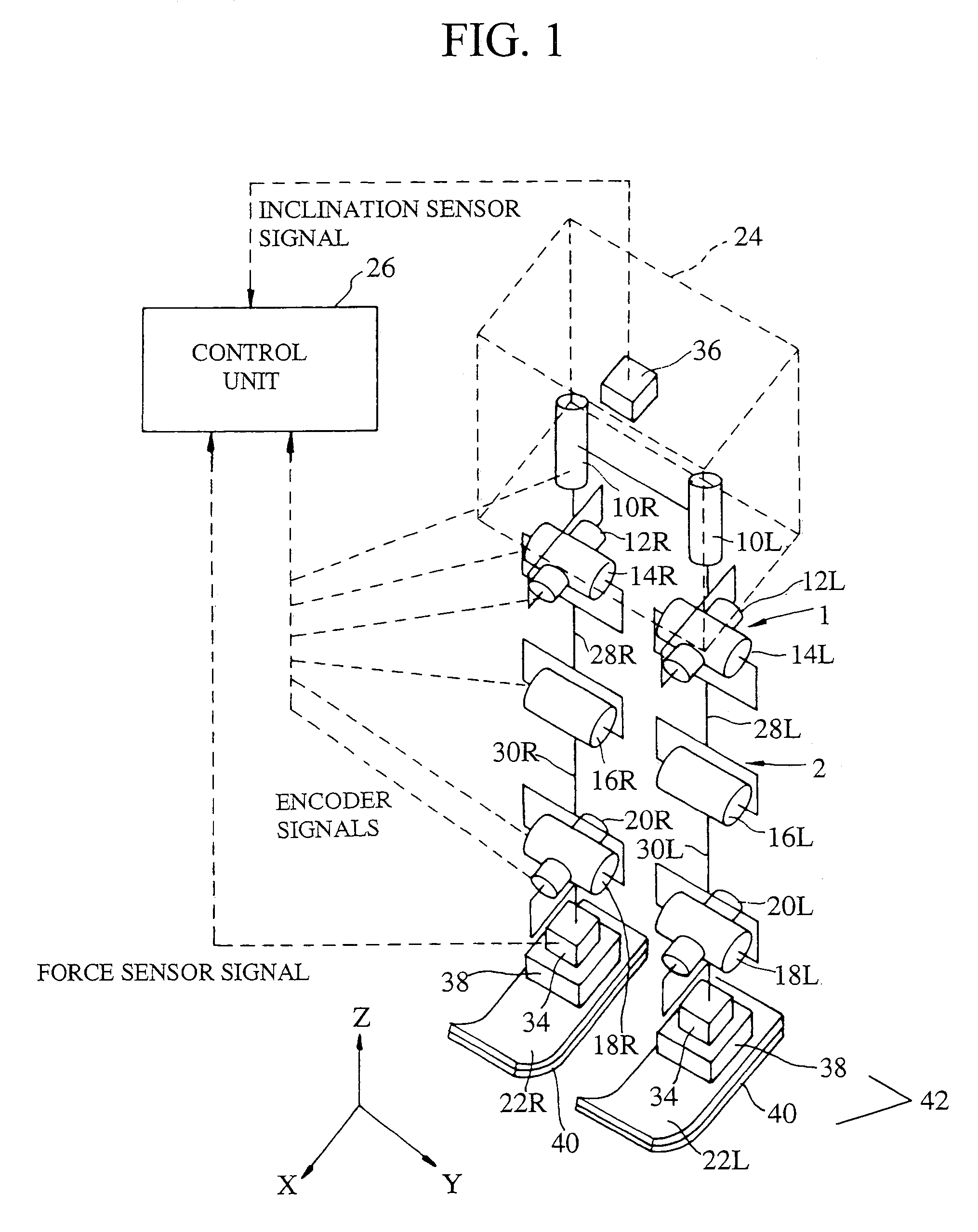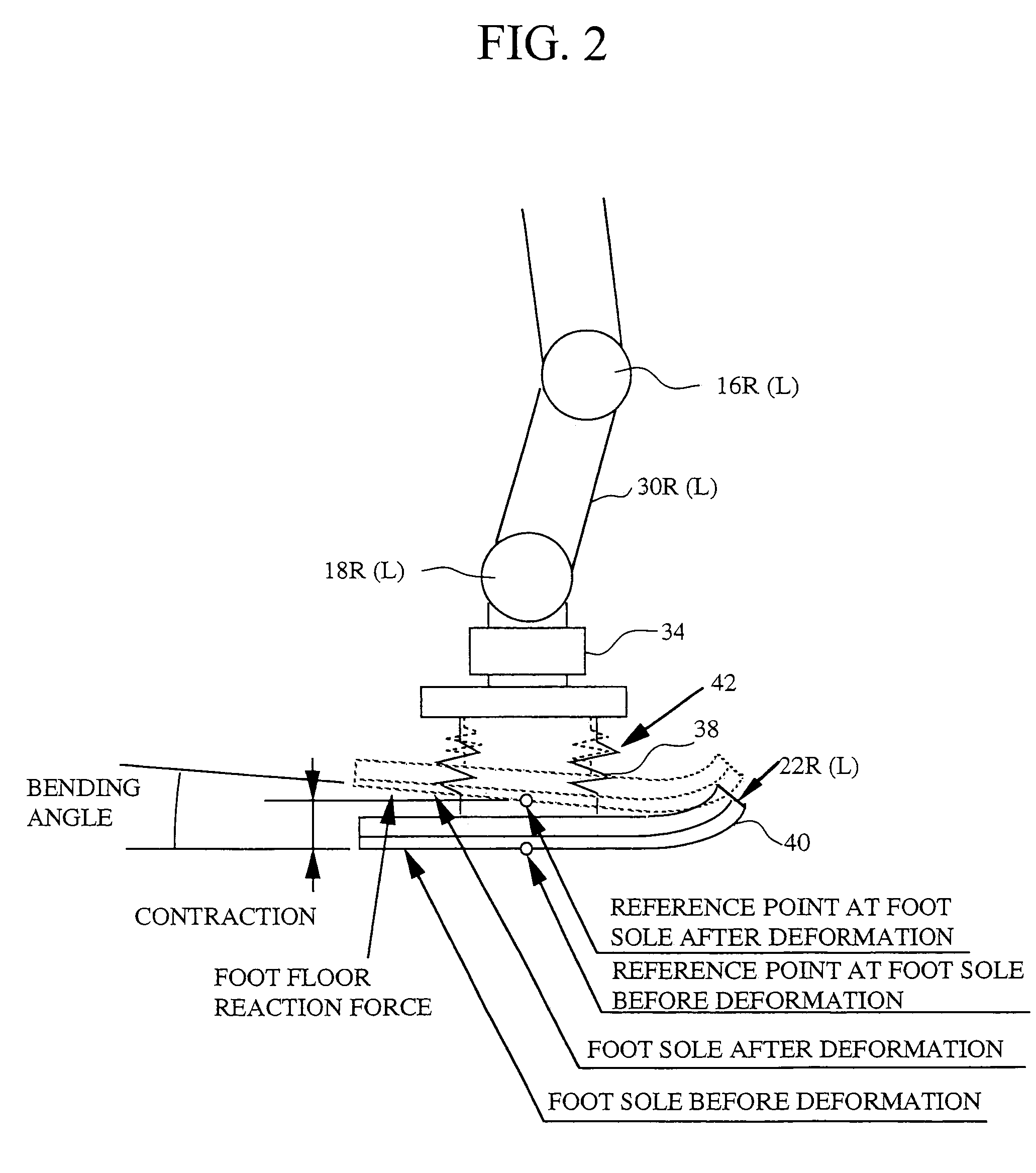Device for generating motion of legged mobile robot
a mobile robot and motion generation technology, applied in the direction of electric programme control, program control, instruments, etc., can solve the problems of inability to generate a gait in real time, failure to meet the dynamic equilibrium condition, and sometimes failure to generate a gait, so as to improve the stability of the postur
- Summary
- Abstract
- Description
- Claims
- Application Information
AI Technical Summary
Benefits of technology
Problems solved by technology
Method used
Image
Examples
first embodiment
[0214]FIG. 16 is a functional block diagram showing the gait correction of the motion generation system according to the
[0215]It should be noted that in all embodiments including the first embodiment (shown in FIG. 16) but excluding eighth to thirteenth embodiment explained later, the gait correction must satisfy the condition expressed in the following equation.
Full-model's ZMP=Desired ZMP+ZMP-converted value of full-model's corrected moment about the desired ZMP Eq. 15
[0216]This indicates that, on the premise that the full-model is a strict model, the gait must be corrected to strictly satisfy the dynamic equilibrium condition. Specifically, the full-model corrector 100c corrects the gait by changing the desired body trajectory in the desired gait comprising the desired body trajectory, the desired foot trajectory and the desired ZMP trajectory, or by generating the desired floor reaction force's moment about the desired ZMP (that is zero in the original desired gait). In the abo...
second embodiment
[0234]FIG. 17 is a functional block diagram showing the operation of the motion generation system of a legged mobile robot according to the present invention. More specifically, it shows the gait correction explained with reference to S32 of the flow chart of FIG. 11.
[0235]The gait correction in the second embodiment is a method to use the inverse dynamic full-model (inverse full-model), a method not to correct the ZMP of the simplified model's gait, and a method to use the perturbation model. Further, it is a method of the full-model feedback correction and is the basic of full-model feedback corrections described in the embodiments up to a seventh embodiment.
[0236]As illustrated, in the second embodiment, a feedback loop is added to the arrangement or structure of the first embodiment. The feedback loop inputs a value obtained by integrating (1 / S; S: Laplace operator) the full-model ZMP's error and by multiplying it by an integral gain (−K that is a value corresponding to a feedba...
third embodiment
[0246]FIG. 23 is a functional block diagram showing the operation of the motion generation system of a legged mobile robot according to the present invention. More specifically, it shows the gait correction explained with reference to S32 of the flow chart of FIG. 11.
[0247]The gait correction in the third embodiment is a method to use the inverse dynamic full-model (inverse full-model), a method not to correct the ZMP of the simplified model's gait, and a method to use the perturbation model. Further, it is a method of the full-model feedback correction and is a general method common to the embodiments up to the seventh embodiment.
[0248]Explaining this with focus on a difference from the foregoing embodiments, in the third embodiment, in order to solve the drawback of the second embodiment, i.e., in order to prevent the perturbation model oscillation, a perturbation model control law 23e is added to the arrangement or structure of the second embodiment in such a manner that a feedba...
PUM
 Login to View More
Login to View More Abstract
Description
Claims
Application Information
 Login to View More
Login to View More - R&D
- Intellectual Property
- Life Sciences
- Materials
- Tech Scout
- Unparalleled Data Quality
- Higher Quality Content
- 60% Fewer Hallucinations
Browse by: Latest US Patents, China's latest patents, Technical Efficacy Thesaurus, Application Domain, Technology Topic, Popular Technical Reports.
© 2025 PatSnap. All rights reserved.Legal|Privacy policy|Modern Slavery Act Transparency Statement|Sitemap|About US| Contact US: help@patsnap.com



